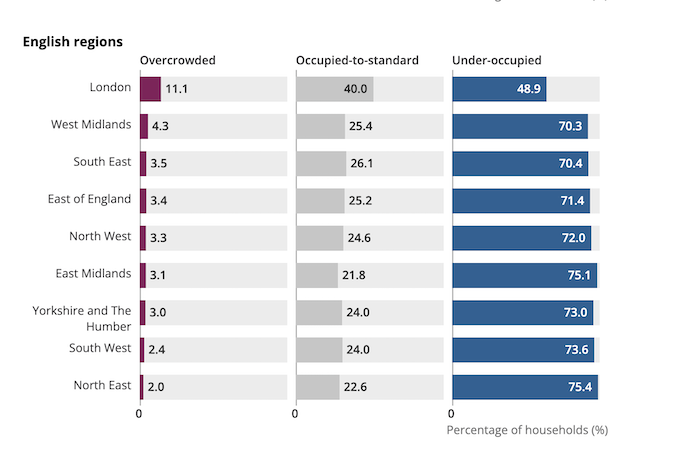The latest batch of data from the 2021 Census confirms yet another way in which London is markedly different from the rest of England – the degree to which its housing stock is over-crowded, under-occupied and just about right. Figure 1 near the top of the Office for National Statistics (pictured below), where the figures are presented, demonstrates this, well, graphically.
Of all the nine English regions, London has by far the highest proportion of dwellings defined as overcrowded – 11.1 per cent, putting the capital far ahead of the West Midlands, which has the second highest at 4.3 per cent, with North East bringing up the rear on 2.0 per cent. A household’s accommodation is defined as overcrowded if it does not contain the number of bedrooms defined by the official Bedroom Standard.
London also has by far the lowest proportion of living accommodation defined by the same measure as under-occupied, meaning houses or flats with more bedrooms than the Bedroom Standard sets down. In London, 48.9 per cent of accommodation was found in the Census to be under-occupied. Again, the West Midlands led a distant chasing pack, with 70.3 per cent under-occupation tapering down to the North East with 75.4 per cent.
And London was also found to be the region with the highest proportion of dwellings where the occupancy level was just right (“occupied-to-standard”). At 40 per cent it was again strikingly different from the rest of England. The nearest region was the South East on 26.1 per cent and once again all the others were clustered together on a similar value, with the East Midlands having the smallest occupied-to-standard rate at 21.8 per cent.

The London occupancy figures also reveal – as is often the case with demographic data about the capital – substantial variations within the overall picture. London has the most overcrowding in every accommodation type, ranging from 7.8 per cent in detached houses to 16.8 per cent in caravans and similar.
More than half of London households, 54 per cent, live in flats or maisonettes, of which 13.7 per cent were overcrowded at the time of the Census. Overcrowding in these types of homes was at its highest in Barking & Dagenham (22.7 per cent) and in Newham (21.8 per cent).
Londoners in rented accommodation are far more likely to be overcrowded than those who own their homes, especially in the social rented sector, where the overall figure was 19.4 per cent compared with 15 per cent for private renters.
At Figure 4 on the ONS page there is a menu from which you can look up the overcrowding figures for individual boroughs. This reveals, for example, that 26.8 per cent of social rented homes in Tower Hamlets are overcrowded, as are 20.9 per cent in Brent, 16.2 per cent in Kensington & Chelsea and 11.5 per cent in Richmond upon Thames.
Overcrowding is very prevalent among London’s lone parent households. Nearly 30 per cent of those with dependent children fall into that category as do 13 per cent of those in which all the children qualify as non-dependent. The greatest proportion of lone parent households with dependent children was found in Westminster, where the figure was an alarming 38.3 per cent. Newham (37.8 per cent) and Tower Hamlets (37.3 per cent) were next.
As for under-occupation, 72.5 per cent of London’s owner-occupied homes are in that group, even as it also has the highest rate of overcrowding in its owner-occupied properties. Richmond and Kensington & Chelsea come high up the lists.
Explore all the the housing occupancy Census data via here.
X/Twitter: On London and Dave Hill. If you value On London and its writers, become a supporter or a paid subscriber to Dave Hill’s Substack for just £5 a month or £50 a year.


I live in London, we’re a couple, gay, no kids. So living in London works for me, but the idea of bringing up a family in London, as somebody that grew up in the north, seems mad (unless you’re pretty lucky in terms of your income). Maybe 1 kid, but more than 1? Madness.
When you can get so much more space outside of London and once you have kids you don’t have the time or money to do many social things anyway, what’s the point of being in London?